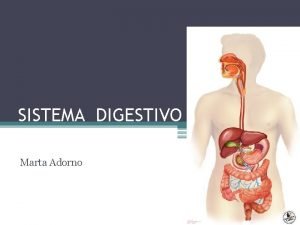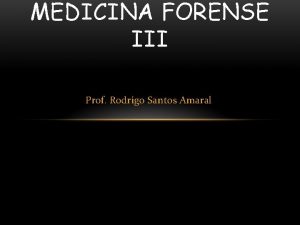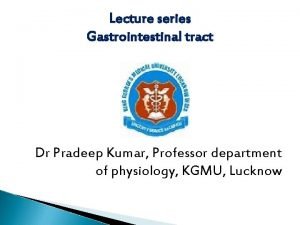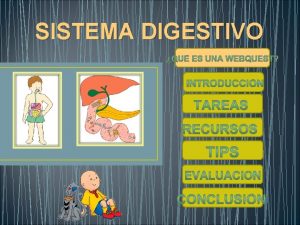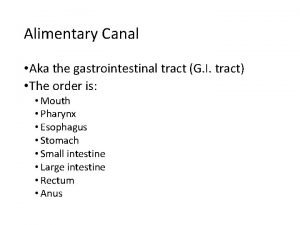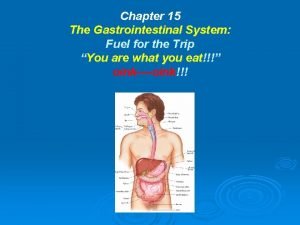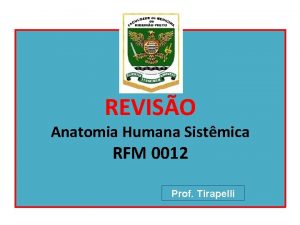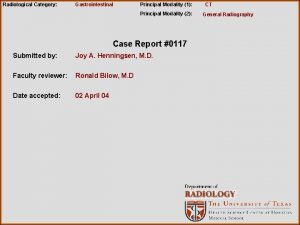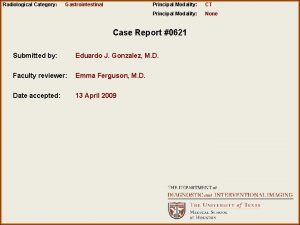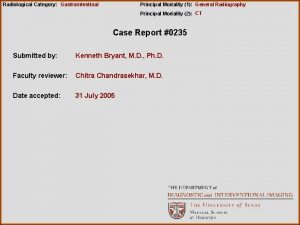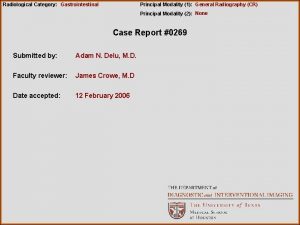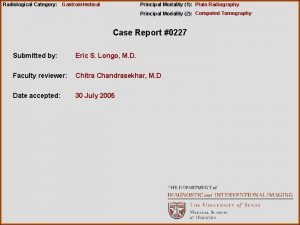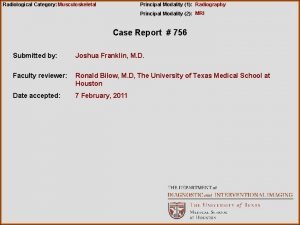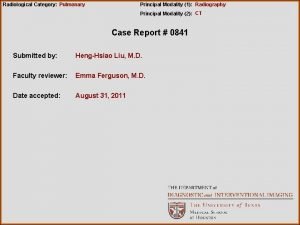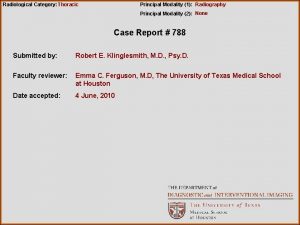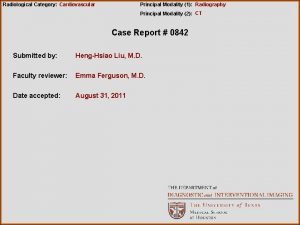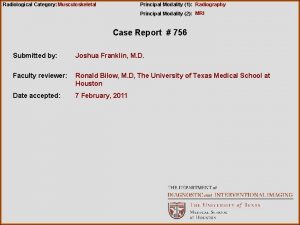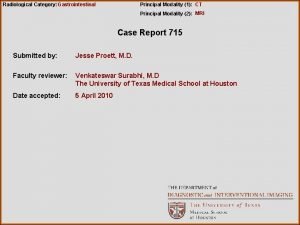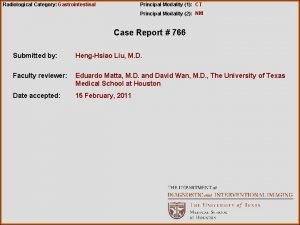Radiological Category Gastrointestinal Principal Modality 1 General Radiography














- Slides: 14

Radiological Category: Gastrointestinal Principal Modality (1): General Radiography Principal Modality (2): CT Case Report #0089 Submitted by: Steve H. Fung, M. D. Faculty reviewer: Chitra Chandrasekhar, M. D Date accepted: 23 February 2004

Case History A 63 year-old woman presents with fever, abdominal pain, distention, and constipation. She had episodes of colicky abdominal pain over the last four years.

Radiological Presentations AP abdominal radiographs

Radiological Presentations Abdominal CT

Radiological Presentations Single contrast barium enema

Test Your Diagnosis Which one of the following is your choice for the appropriate diagnosis? After your selection, go to next page. • Emphysematous cholecystitis • Foreign body with colonic perforation • Gallstone ileus • Diverticulitis with pericolonic abscess and inspissated fecalith • Obstructing colonic carcinoma

Findings A B The AP radiograph of the upper abdomen (A) shows a round calcification (arrows) and an adjacent gas collection (arrowheads) in the expected location of the gallbladder. The AP radiograph of the lower abdomen (B) demonstrates two larger concentrically laminated calcifications (arrows) in the left lower quadrant overlying the sigmoid colon. The colon is dilated proximal to the laminated calcifications, which are most likely the sources of the large bowel obstruction.

Findings A B On the abdominal CT image of the upper abdomen (A), there is a calcified gallstone (arrow) as well as an air-fluid level (arrowhead) in the gallbladder lumen. In the lower abdomen (B), one of the previously described concentrically laminated calcifications (arrows) is present in the lumen of the sigmoid colon. The colon is dilated proximal to this calcification, and no other mass is identified around this transition point. This finding confirms that the calcification in the sigmoid colon is the source of the large bowel obstruction.

Findings Single contrast barium enema images demonstrate contrast outlining the lumen of the air-filled gallbladder (arrowheads), confirming the presence of a cholecystocolonic fistula. The calcified gallstone within the gallbladder lumen is labeled (arrows).

Discussion A B Two years prior to her present study, the patient had an abdominal radiograph (A) that demonstrated multiple concentrically laminated calcifications in the expected location of the gallbladder and no calcification in the left lower quadrant. This confirms the previous location of her gallstones before they had migrated into her sigmoid colon. Gross pathology (B) of the specimens extracted from the rectum are consistent with laminated gallstones.

Discussion The findings on the present study are consistent with gallstone ileus 1 -3, which is a rare complication in patients with cholelithiasis (<1%), related to chronic cholecystitis in which a gallstone erodes through the gallbladder wall into an adjacent bowel with subsequent bowel obstruction. The most common site of perforation is into the duodenum through a cholecystoduodenal (60%) or choledochoduodenal fistula, and the most common site of obstruction is at the terminal ileum (60 -70%), followed by the proximal ileum (25%) and the distal ileum (10%). In rare cases, the gallstone may erode into the stomach through a cholecystogastric fistula with subsequent obstruction at the pyloris or duodenum (Bouveret syndrome)4. In the present study, two gallstones have eroded into the colon through a cholecystocolonic fistula with obstruction at the sigmoid colon. The classic radiological triad of findings described by Rigler, et al. 1 are: 1. Partial or complete bowel obstruction 2. Pneumobilia 3. Ectopic calcified gallstone However, diagnosis by conventional radiography is seen in only 30 -35% of cases 2, since not all gallstones are radiopaque on conventional radiography, and pneumobilia may be absent. 1. 2. 3. 4. Rigler LG, et al. Gallstone obstruction: Pathogenesis and roentgen manifestations. JAMA 1941; 117: 1753. Grumbach K, et al. Gallstone ileus diagnosed by computed tomography. J Comput Assist Tomogr 1986; 10: 146. Reisner RM, Cohen JR. Gallstone ileus: A review of 1001 reported cases. Am Surg 1994; 60: 441. Bouveret L. Revue de Médecine 1893.

Discussion Other considerations: Emphysematous cholecystitis is a rare complication of acute cholecystitis related to the presence of gas-forming organisms (commonly Clostridium welchii, Escherichia coli, and Enterobacter aerogenes) in or around the gallbladder wall. It is most common in patients with diabetes mellitus and elderly men, probably related to small vessel disease of the cystic artery. While perforations, air-fluid level in the gallbladder lumen or pneumobilia may be present, the most specific finding is intramural gas in the gallbladder wall or pericholecystic space 1, 2, which is not seen in the present study. Foreign bodies in the colon, either ingested 3 -5 or retrograde inserted 6, 7, may cause large bowel obstruction or perforation from direct trauma or erosion of the intestinal wall. While the concentrically laminated calcifications in the present study may represent concretions as a reaction to a foreign body, this does not adequately explain why there is a gallbladder perforation when the laminated calcifications are in the sigmoid colon. 1. 2. 3. 4. 5. 6. 7. Mc. Millin K. Computed tomography of emphysematous cholecystitis. J Comput Assist Tomogr 1985; 9: 330. Andreu J, et al. Computed tomography as the method of choice in the diagnosis of emphysematous cholecystitis. Gastrointest Radiol 1987; 12: 315. Cohen MI, et al. Intestinal obstruction associated with cholestyramine therapy. N Engl J Med 1969; 280: 1285. Melchreit R, et al. “Colonic crunch” sign in sunflower-seed bezoar. N Engl J Med 1984; 310: 1748. Steinberg JM, Eitan A. Prickly pear fruit bezoar presenting as rectal perforation in an elderly patient. Int J Colorectal Dis 2003; 18: 365. Yaman M, et al. Foreign bodies in the rectum. Can J Surg 1993; 36: 173. Fry RD. Anorectal trauma and foreign bodies. Surg Clin North Am 1994; 74: 1491.

Discussion Other considerations (cont. ): Diverticulitis is a common complication of colonic diverticulosis and is seen mostly in the sigmoid colon of elderly patients in industrialized nations, probabaly related to increased intraluminal colonic pressures and prolonged colonic transit times from a fatty, low-fiber diet. It is thought to be caused by obstruction of the diverticular neck with fecal material and subsequent inflammation of the peridiverticular tissues. While giant obstructing fecalomas from inspissated fecaliths 1, pericolonic abscesses and fistulous tract formation may be uncommon complications, there should also be inflamed diverticuli, colonic wall thickening and pericolonic fat stranding on CT 2 -4, none of which are seen on the present study. 1. 2. 3. 4. Dogra PN, et al. Radiopaque shadow in the lumbar region on plain X-ray abdomen: Diagnoistic dilema. Int Urol Nephrol 2002 -2003; 24: 485. Johnson CD, et al. Diagnosis of acute colonic diverticulitis: Comparison of barium enema and CT. AJR Am J Roentgenol 1987; 148: 541. Cho KC, et al. Sigmoid diverticulitis: Diagnostic role of CT-comparison with barium enema studies. Radiology 1990; 176: 111. Rao PM, et al. Helical CT technique with only colonic contrast material for diagnosing diverticulitis: Prospective evaluation of 150 patients. AJR Am J Roentgenol 1998; 170: 1445.

Diagnosis Gallstone ileus with obstructing gallstones at the sigmoid colon and cholecystocolonic fistula
 Erate category 1
Erate category 1 Center for devices and radiological health
Center for devices and radiological health National radiological emergency preparedness conference
National radiological emergency preparedness conference Radiological dispersal device
Radiological dispersal device Tennessee division of radiological health
Tennessee division of radiological health Diagram of alimentary canal
Diagram of alimentary canal Emt chapter 18 gastrointestinal and urologic emergencies
Emt chapter 18 gastrointestinal and urologic emergencies Vestíbulo da boca
Vestíbulo da boca Equimosis colores
Equimosis colores Intestinal villus
Intestinal villus Embriologia del sistema gastrointestinal
Embriologia del sistema gastrointestinal Gastrointestinal tract
Gastrointestinal tract Nursing care for gastrointestinal disorders
Nursing care for gastrointestinal disorders Chapter 15 the gastrointestinal system
Chapter 15 the gastrointestinal system Sistema digestorio
Sistema digestorio







